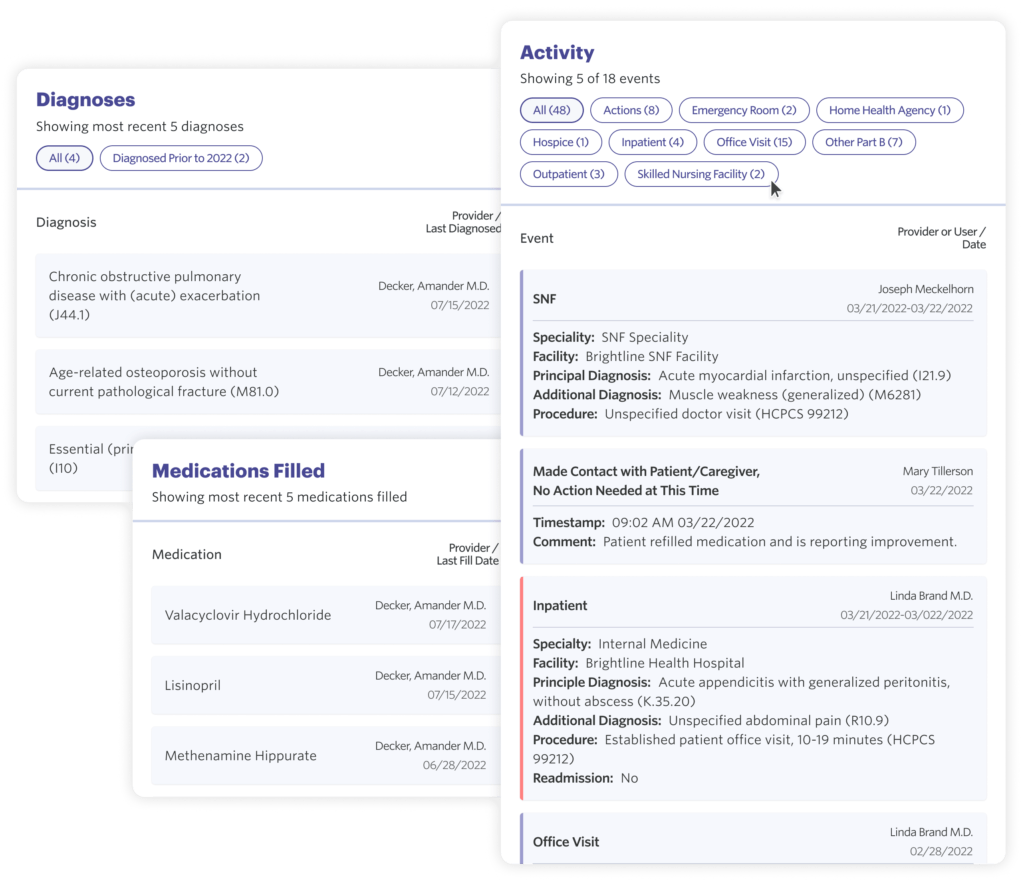Key Points
- Patient View distills clinical and administrative patient data across providers and facilities down to what’s essential for providers to stay up to date on patients over time. It supplements a practice’s EMR, which may not include information about visits that occur outside of the provider’s practice.
- Patient View’s detailed look into patient data complements our recently-launched Panel View, which provides a high-level overview of a practice’s patient population and enables a more proactive approach to managing patients.
- Practice staff should use Patient View to prepare for Medicare appointments by scanning for important changes since a patient’s last visit, including: new medications that should be reconciled, diagnoses that should be re-evaluated, and recent activity that should be asked about.
- Patient View will continue to evolve as we integrate with new data sources – with the addition of transitions-of-care notifications coming next.
Show me the… Patient
Providing the best care requires a comprehensive understanding of a patient’s journey across all parts of the healthcare ecosystem. However, most providers face an information gap. While the Electronic Medical Record (EMR) is a valuable source of information, it relies on either clinical staff inputting data manually or having interfaces with other offices, labs, and systems to send it patient information. In practice, the data displayed in the EMR is far from comprehensive and leaves providers with an incomplete picture of a patient’s health.
When discussing with clinicians what they would need in order to provide higher quality care for their Medicare patients, they tell us again and again how impactful it would be to have a full understanding of their patients’ health – not only because they’re responsible for their patients’ well being, but also because in a value-based world, providers are responsible for managing total cost of care. Activities and medications prescribed outside of the primary care office (e.g. ER visits, inpatient stays, and specialty medications) can be among the most expensive.
One provider, for example, noted the strong correlation between medication adherence and favorable long-term outcomes. However, his current system fails to keep him sufficiently updated on the specialty medications prescribed outside his practice, despite their impact on patient health and cost of care. Without full visibility into his patients’ medications, he is not able to educate or appropriately intervene if needed.
With tools to increase visibility into care outside of their offices, clinicians are better able to fill in the gaps and improve patient care.
How it works
Patient View uses Medicare Claims data to present all patient-related information to a practice user. Data is divided into several categories for easier viewing: Medications, Diagnoses, and Activities.

The goal of Patient View is to provide an easily scannable, yet deeply informative page for practice clinical staff. As we’ve created it, we’ve also been careful to ensure that it is a framework we can build upon as we integrate with more systems. We’re currently incorporating CCLFs as a data source, and we’re working quickly to incorporate ADT notifications, patient communications capabilities, and other exciting improvements.
Designing for growth
Given how rapidly our platform and our customer base is expanding, it has been critical for us to ensure that our initial designs have been motivated by three key attributes: user centricity, flexibility, and intelligence.
- User Centricity: Understanding our users’ needs to ensure we’re providing information that is useful and fits within their workflow.
- Flexibility: Presenting information in a clear, structured format that enables us to add new information and data sources as we grow.
- Intelligence: Analyzing what is likely to drive a patient’s health issues and level of risk and highlighting the events that contribute to that risk.
We’re proud of the value that Patient View is already bringing to our network of practices, and we’re looking forward to its continued evolution.


